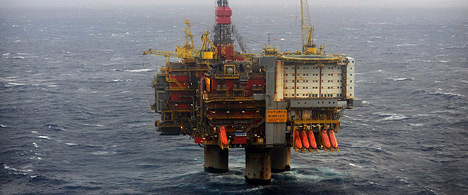
The Statfjord A platform in the North Sea. (Photo: Marit Hommedal)
After the oil spill StatoilHydro initiated several environmental investigations in order to identify and, if required, reduce the environmental impacts.
Sintef, the Institute of Marine Research (IMR) and the Norwegian Institute for Nature Research (NINA) have also been involved in this investigation. The report is now ready and the specialists conclude that the oil spill of around 4400 m3, which is the second largest on the Norwegian continental shelf, did not cause any demonstrable environmental harm.
Three days after the incident there were no longer any visible traces of the oil on the sea surface. Analyses from Sintef show that after a couple of days 25% of the oil had evaporated and 15% had dissolved. The rest of the oil had been mixed into the churning water as droplets, gradually dissolving and eaten by the ocean’s own bacteria.
“Because of heavy waves and wind, the oil was quickly mixed into the sea,” says Hanne Jorun Storhaug Ervik, StatoilHydro’s project manager for the investigation. The weather conditions were on our side and nature took care of itself.
Measurement of oil components in fillet of fish from the North Sea caught in December and January indicate that all components were below the detection limit.

"No harm to the environment close to Statfjord has been proven, even though the oil spill was a very serious incident," says Eva Øglænd Bjørnestad, environmental coordinator for Statfjord. (Photo: Harald Pettersen)
“More than 170 fish samples have been analysed without any traces of oil being found in the fish fillets,” says Bjørn Einar Grøsvik of the IMR.
“Consequently, there is no reason for saying that the spill has reduced the quality of North Sea fish fillets.
Other analyses of oil components in liver show slightly higher oil values in haddock during the first days after the spill than what has been reported earlier in haddock caught in the North Sea. This was, however, not the case for cod and pollack. Furthermore, no dead birds were found after the oil spill.
The purpose of the investigation was to identify and reduce the environmental impacts of the Statfjord oil spill.
“Our goal is zero harm to the environment in which we operate, and we immediately started extensive investigations and analyses,” says Eva Øglænd Bjørnestad, environmental coordinator for Statfjord.
The work has been carried out in good cooperation and full openness with external experts (SINTEF, IMR and NINA), in addition to our in-house technical expertise.
“We have gained further knowledge about environmental affects of oil spills and experience that will be useful both to StatoilHydro personnel and external professional communities,” says Ms Bjørnestad.